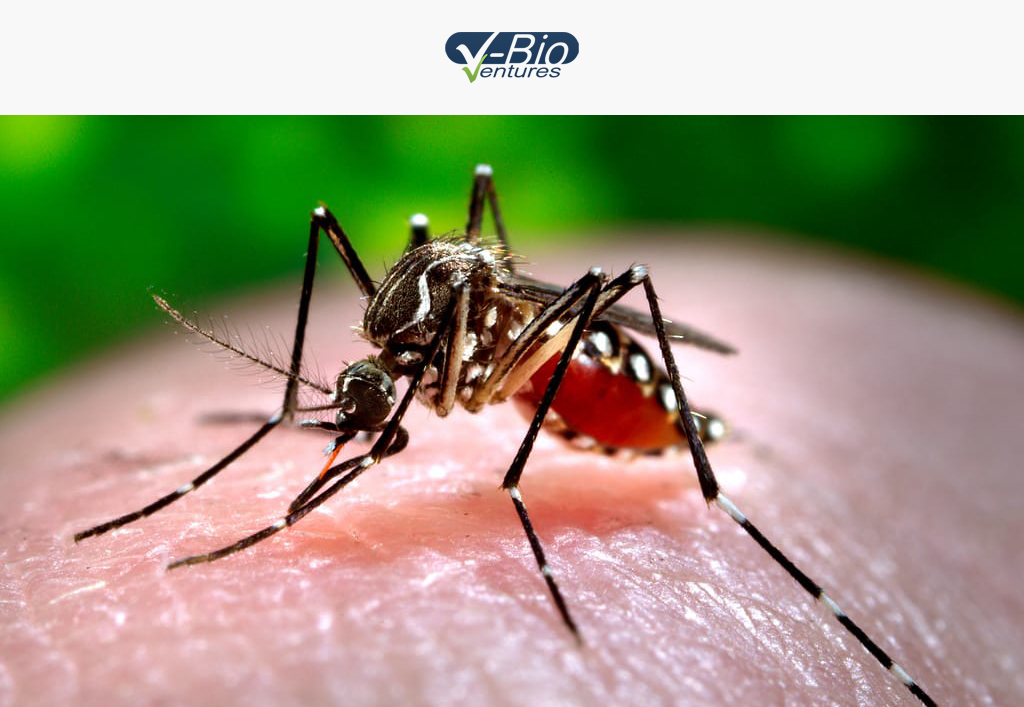

Mosquitoes are carriers of a range of crippling diseases, posing an enormous global health burden. Because current methods based on insecticides are inadequate, new tools are urgently needed. Widely different companies are tackling the problem of mosquito control from very different angles; who will be successful in getting a grip on these tiny flying terrors? A view by V-Bio Ventures.
Mosquitoes are carriers of a range of crippling diseases, posing an enormous global health burden. Because current methods based on insecticides are inadequate, new tools are urgently needed. Widely different companies are tackling the problem of mosquito control from very different angles; who will be successful in getting a grip on these tiny flying terrors? A view by V-Bio Ventures.
The field
While a tiger or a great white shark might seem like a more dangerous encounter, the most lethal animal on the planet is actually the mosquito. These little bloodsuckers cause about one million deaths annually through their transmission of various pathogens, including malaria, dengue, and the recently resurfaced zika virus.
Mosquitoes and the diseases they transmit are recognized as a global health threat by the World Health Organization (WHO), basically placing them on the top of the organization’s “most wanted” list. Scientists have been looking for efficient ways to control the insect population for decades. Current methods rely heavily on chemicals as insecticides, but next to high costs, resistance and worries concerning their effect on human health and the environment, the use of chemicals is unsustainable and inefficient in eradicating large groups of mosquitoes. An alternative would be the use of x-ray irradiation to breed sterile males (aka the Sterile Insect Technique or SIT), which was successful in controlling several agricultural pests. However, SIT significantly reduces the mating fitness of male mosquitoes. As SIT causes infertile males to provide little mating competition for the fertile males, the technique is rendered useless in mosquitoes.
The players
Luckily, companies ranging from smaller biotechs to technology giants are working on innovative ways to get a grip on the flying terrors.
One of those tech giants is the widely known Microsoft, which has been busy designing a new and improved mosquito trap. The trap is capable of encaging only a certain type of mosquito instead of the plethora of insects caught in conventional traps. Microsoft’s smart trap also tells researchers when the mosquito was trapped and what the temperature and humidity was when the critter was caught. By using these data, researchers can learn new aspects of mosquito behavior, hopefully helping us in our battle against them.
Second technology heavyweight in the mosquito field is reigning search engine champion Google. Their healthcare branch, Verily, is looking to use the bacterium Wolbachia as a form of mosquito birth control. When males infected with Wolbachia mate with normal females, the bacterium interferes with fertilization, preventing the development of offspring. A similar strategy is also being followed by MosquitoMate, which has already done some field testing with the technology.
More controversial is the approach of Oxitec. The Oxford-based biotech, acquired by Intrexon for $160 million, genetically engineers a lethal gene into male mosquitoes. In the absence of a specific compound, development is halted and the mosquitoes die. Thus, mosquitoes can be bred in the lab in the presence of this compound, but when the males pass this gene to their offspring in the environment, the offspring are not viable. However, public opinion is divided over the idea of releasing genetically engineered bugs into people’s back yards.
To circumvent the permanent genetic engineering, Forrest Innovations goes for an RNAi strategy—larvae are soaked in a solution containing double-stranded RNAs, which knocks down certain fertility genes. This technology creates sterile, non-GMO males without the regulatory hassle of GMO mosquitoes or the potential spread of Wolbachia bacteria. Additionally, Forrest Innovations is working on ways to distribute their mosquitoes. While spreading infertile fruit flies can be done using air drops, mosquitoes don’t survive the process. Forrest is now working on innovations to make the six-legged biters survive an aerial maneuver.
The race
Which company will be the first to come up with an economically viable, regulatory-approved, effective method to suppress mosquitoes’ spread of deadly diseases? The unusual mix of biotech companies and technology heavyweights makes this an interesting race to follow.
Perhaps the smaller, more flexible companies such as Forrest Innovations will be able to outsmart the larger players straying from their comfort zones. But who will fund these smaller undertakings? The risk and competition in the market make it more suitable for larger venture capital funds that can afford to place a bet, so they are the more obvious candidates.
An important challenge is the intended customer; public authorities will need convincing before allocating their funds to experimental approaches. But once they are convinced, companies can be assured of a steady income. Huge areas are at risk of mosquito-borne diseases, and considerable upscaling will be needed to cover them all.
